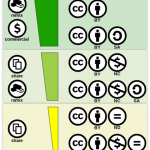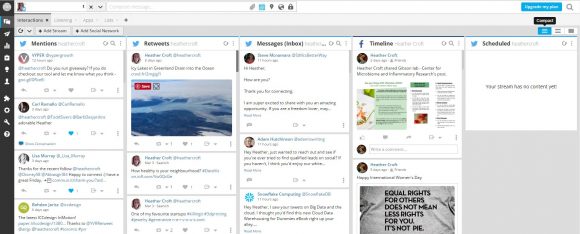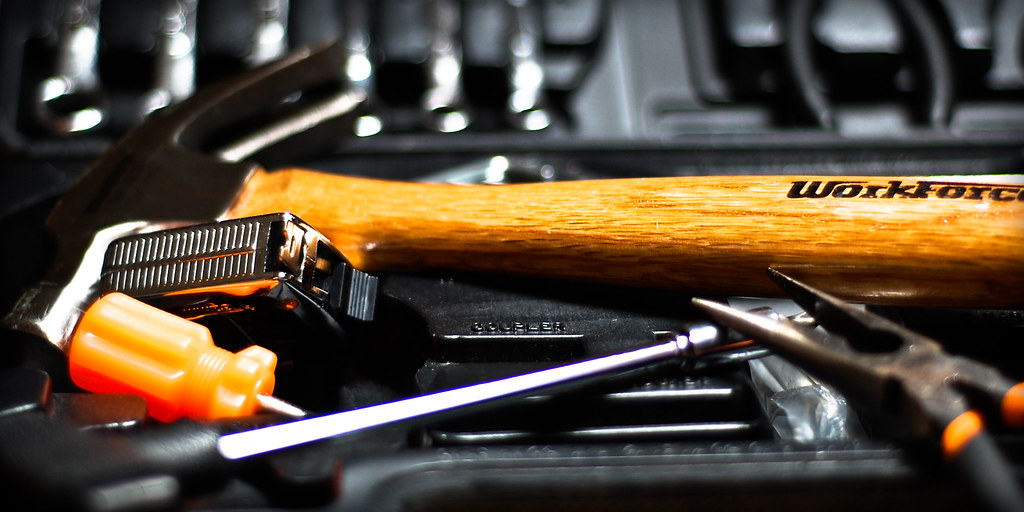I am writing this down because the month of October was a tragedy of proportions that I do not want to ever repeat or revisit.
My Dad was frustrated with by the dearth of descriptions for what happens to people who are diagnosed with pancreatic cancer. I hope that this countdown will help answer questions that others out there facing this diagnosis may have.
A couple of days after my Mom’s 71st birthday, my parents left Victoria for a cycling holiday in France. I am so fortunate to have parents who are healthy and active and able to travel.
I kept track of their adventure on Facebook as my Mom never managed to update her email contacts after I changed my address a couple of years ago. They were enjoying all of the food, wine and culture that the city of lights and the surrounding countryside had to offer.
32 Days
For me, the nightmare started with an email from my Dad. I was getting coffee with friends when I read this:

Immediately in shock, I stood there dumb, showing my friends the message until one of them herded me into the sun outside and then back to my office. The ride home felt surreal as my legs had lost all their power and I couldn’t catch my breath even though I was going so slowly. I probably looked drunk.
Once I got home, I texted my aunt who was in dialysis to tell her to check her email. She called me as soon as she knew and we decided to meet at her house. My other aunt and uncle were already there when I arrived and we hung out like zombies until it was clear that we had done all for each other that we could do.
31 Days
I headed out to the airport hours early to pick my parents up. The waiting was awful because I didn’t know how to expect my Mom.
Relief flooded into every cell of my being as my parents glided through the arrivals gate – they looked the same! My Mom’s always been a very fast walker and I felt my own stress ratchet back step by step as I chased after her across the airport.
The next couple of days passed normally as I gave my parents space to get over their jet lag and my Mom waited to hear back about the results from her blood tests.
28 Days
We invited my parents over for Friday night pizza and made plans for my daughter to come over after school the following week to work on a craft project. Here’s the last text she sent me nagging me to pick up the right type of card stock:
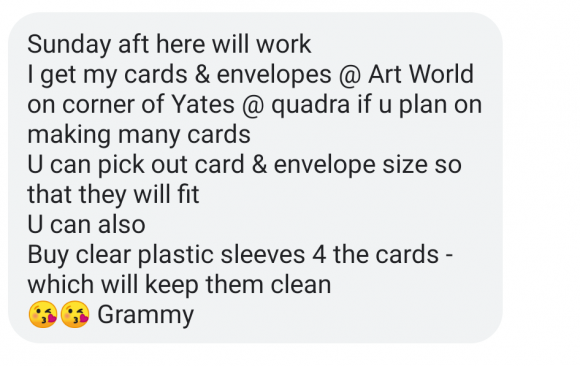
I look back fondly on this week as the brief period that my Mom “just” had cancer.
24 Days
My Mom was asked to return to the hospital for a needle biopsy on the Tuesday after Thanksgiving.
23 Days
When we went over on Wednesday evening to start the craft, my Dad met us at the door to say that Mom had been throwing up all day possibly due to some of the pain medication and that her family doctor was doing a house call.
The dread pressed down heavily as we worked in my Mom’s studio without her there but surrounded by her presence. I tried to put on a brave face for my daughter, but there’s no way she missed it.
22 Days
Shaken up from Wednesday, I avoided my parent’s house in the morning, but decided to go over at lunch. Witnessing the toll that whatever had happened on Wednesday took out of my Mom turned me into a useless worker drone that afternoon.
I would need to find a better time of day to visit. It was clear that I would need to see my Mom every day from now on, but I wasn’t sure how to fit this into my children and work-filled day.
21 Days
My Dad had been invited out on Friday night, so I ordered White Spot and headed over to their house with my box of yam fries.
I found my Mom cocooned on the couch in my Dad’s office, where she’d been since Wednesday. She was lying on her side wrapped in quilts she had made and sat up when I joined her. Her eyes were blinking out-of-sync like a baby owl and her proprioception was way off – she couldn’t itch her nose or get the straw to her mouth.
She showed me the needle biopsy bruise as well as the bruise on her mid-back – a harbinger of what was coming down on us if any of us (including her family doctor) had known what to look for.
I also noticed that she had a lot of other small bruises the size of dimes on her arms as legs as well as pinprick hematomas under her nails. I’m sure I’ve read somewhere that both are signs of serious health problems and I wondered how long that they had been there.
Mom had an MRI booked at the hospital that was about 30 min away, so I stayed with her until the medi-van came to whisk her away. I spent the evening axe throwing to celebrate a friend quitting her job. Never was there a more perfect time to be throwing sharp objects!
19 Days
A ray of light shone, as it was the day that we had planned to make the bulk of the crafts for my daughter’s school project. We picked up her best friend and crowded into my Mom’s studio.
My Mom joined the girls and directed the production line from under a pile of quilts in her rocking chair. I shared tea with my Dad and when I checked in, they were singing Guiding songs together as they worked. It was absolute magic.
I noticed my mom’s dexterity was making her fumble as she prepped the card stock for stamping, but it was so subtle that the kids didn’t notice anything was off.
18 Days
I played the part of the peanut gallery while my parents met with the doctor who carries out medically-assisted death in Victoria. A two hour meeting, with about an hour spent assessing my Mom. She did about as well as I would with spelling things backwards and counting up and down by multiples. The doctor had her draw a clock face which is something that I had read about in ‘Brain on Fire’. This was difficult for her, and even though it was hard to sit quietly while the testing went on, I was relieved to see that the cancer was leaving her mental capacity alone even as it ravaged her physical being.
I returned to work that afternoon in the strangest head space having just met the person who would potentially be ending my Mom’s life.
I think this is the day that my parents got the official results of the liver biopsy – a diagnosis of pancreatic cancer with metastasis to the liver.
16 Days
Having decided that the most effective as far as being helpful/ least upsetting time of day for me to visit was after dropping off my youngest daughter at school, I headed over to my parents.
My dad texted a heads up that my Mom had lost mobility on one side of her body and that I would need to be prepared to help her even more that I had to get her ready for the day.
13 Days
Friends delivered pumpkins
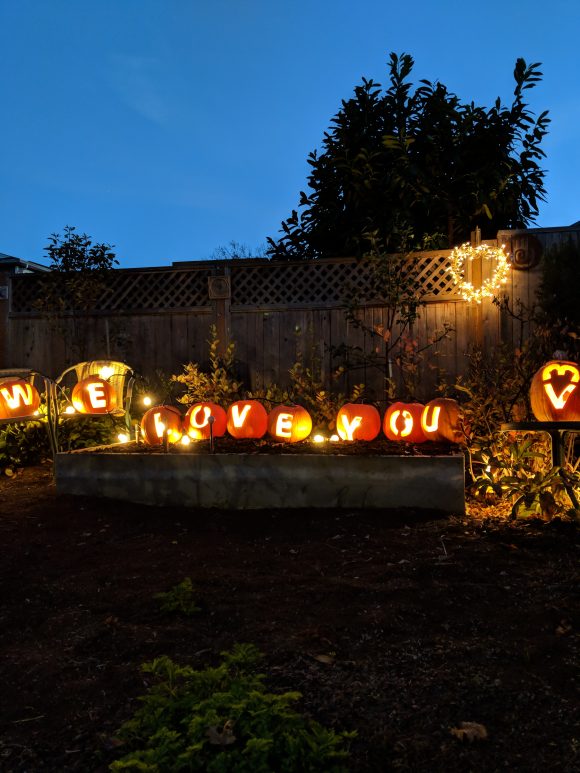
10 Days
I got a text from my Dad in the middle of the night letting me know that he had called an ambulance and that my Mom was in emergency. I told him to try and get some sleep and that I’d head over there as soon as I was able.
I held my Mom’s hand as we waited. She was in so much distress -overheating and clammy and felt like she had an elephant sitting on her chest. My Dad arrived as we waited in a hallway to have a CT scan that would diagnose a clot in her carotid artery. This is probably what had be causing the stroke-like symptoms.
9 Days
Mom spent the night in emergency and received Plaxil, a type of anti-clotting agent that stops clots from forming. Her condition was too fragile for her to receive the other type of anti-clotting drug that could break up the clots that had already formed.
Mom moved into a bed in Hospice, which I immediately started referring to as “The Hotel” because it’s more like home than a hospital.
8 Days
I visited my mom after dropping my daughter off at school. We were both so sad and absolutely not ready to say goodbye.
She said “I met your friends” which I chalked up to the effects of the many drugs she was taking. But then I learned that I have three (!!!) friends who work at Hospice. One of whom kindly gave the grief counselor a heads-up that we would be returning the next day with our kids. Much respect to their work!
I called a nurse to help her go to the bathroom because I was afraid that I would drop her and she would bleed out internally because of the Plaxil. Mom was being encouraged to drink massive quantities of the same laxative that my cat uses.
7 Days
My girls stayed home from school so we could all go visit Grammy. We showed up way too early and had to wait in the lounge while the nurses helped her wake up. There were some great puzzles that the kids didn’t want to leave.
My Mom’s family doctor got the whole family together to get us all on the same page. He patiently answered all of our questions and made it clear that there was a big risk of blood clots causing more stroke symptoms and my Mom could lose her ability to consent to a medically assisted death.
6 Days
I was heading out the door to Hospice when both girls asked to come along. As they put their shoes on, I marveled at how comfortable Hospice must have felt that they wanted to return.
My daughter’s 11th birthday party. Gratitude for the foresight that we had planned a low, low-key party. 12 girls, pizza, Netflix.
5 Days
Dad noticed Mom’s left foot was not a normal colour. I had the great idea that I wanted to get my Mom to read one of those books you can get at Hallmark so that we would always be able to hear her voice.
4 Days
My daughter’s 11th birthday. Last time complaining to my Mom about family drama. Mom looked quite jaundiced when I came into her room. Her leg was quite painful
3 Days
Mom started a Fentanyl pump and adult diapers.
2 Days
Halloween. As the kids headed down the street to trick-or-treat at neighbours that live close to my parents, my Dad let me know that they had picked a date two days out for my Mom’s death. 9 pounds of candy collected. Heart pumping backyard fireworks.
Dad requested that my sister and I figure out some kind of ceremony for the death. We had an extremely dissatisfying conversation where nothing we came up with seemed right. How could it?
After we got of the phone, I jotted some notes and texted them to her. This became basically what we did.
1 Day
We let the girls know that this would be their last visit with Grammy. We took a little while to let them figure out how they wanted to say goodbye. My little made a book about a horse that was mistreated and then finally made a friend with a cat. They escaped to freedom together.
My eldest chose to sign “Riptide” which was how my Mom’s ukulele band always closed out their shows. She’s got a great voice and we all balled hopelessly as she sang.
My husband took a photo of me cuddling with my Mom in her Hospice bed and it wasn’t until I saw the image on his phone that I realized how frail she looked.
Event Horizon
The Day of the Dead.
Things my kids have said that have broken my heart:
- I’ll never get to go to France with Grammy
- Be gentle with me – I’m so sad right now
- I makes me too sad to talk about it (leaves room)
- My eyes just start watering for no reason
Things that I’m trying not to regret but are haunting me daily
- I was always annoyed that my Mom left me voicemails instead of texting. Where it would have been so simple to save just one, I deleted them all.
- There was just no time. Mom started fentanyl the day I realized that I wanted to get a recording of her reading a book to my kids
- Two women my age who are leaders in the community called my Mom their mentor. What the heck was I missing?
Things I’m grateful for
- That we let the relationship between my children and their grandparents grow organically
- That my Mom was a prolific maker. I sleep under a quilt she made and her handiwork is all over the house.
- That my Dad is a popular guy – he has a big, strong friends network that can help support him while he figures out what it looks like to have the house to himself
- That my family all lives so close by
- That my sister is on maternity leave so she can give me a hug on my lunch break
- My perfect little lap dog
- My husband who was able to intercept some of the drama and diffuse the intensity when I couldn’t even
Links to resources


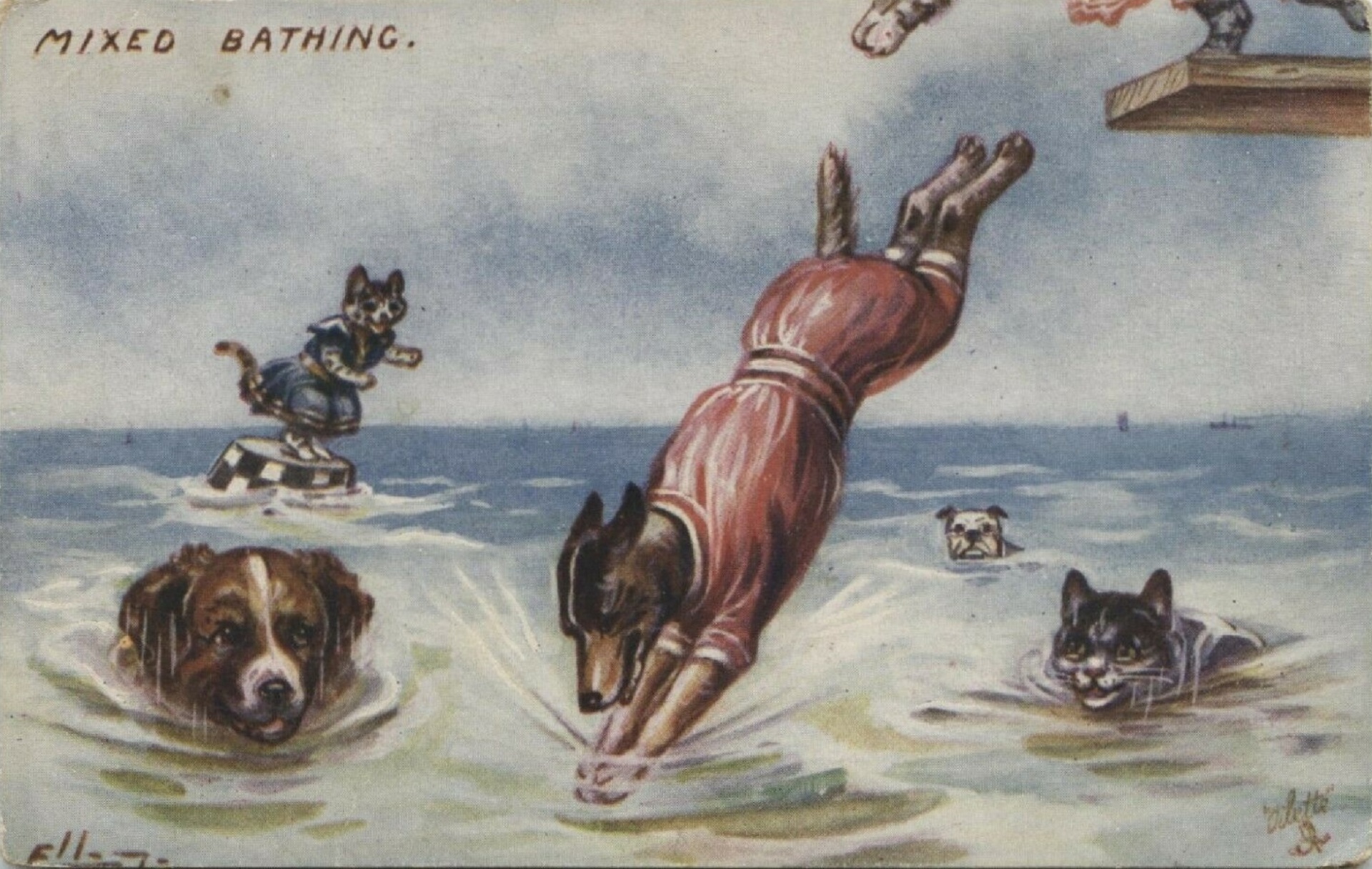 The warm summer sun hung silently over the huge grassy meadow where a very large gathering of animals discussed various worldly issues in many languages. Great Lion surveyed the assembly. Most of the delegates were there. A few had refused to attend, and others had become extinct since the last summit. However, he recognized most of the old faces as friends and allies. It seemed like years since he had seen some of them, ten years to be exact. The United Society of Animals for a Better World met only once a decade, because it was so difficult to gather a representative from each species.
The warm summer sun hung silently over the huge grassy meadow where a very large gathering of animals discussed various worldly issues in many languages. Great Lion surveyed the assembly. Most of the delegates were there. A few had refused to attend, and others had become extinct since the last summit. However, he recognized most of the old faces as friends and allies. It seemed like years since he had seen some of them, ten years to be exact. The United Society of Animals for a Better World met only once a decade, because it was so difficult to gather a representative from each species.


